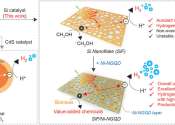Team develops eco-friendly high-efficiency photocatalysts that convert atmospheric carbon dioxide into fuel
The team led by Professor In Soo-Il in the Department of Energy Engineering at DGIST has developed a high-efficiency photocatalyst capable of converting carbon dioxide (CO2), a major contributor to global warming, into the ...
Sep 20, 2023
0
6







